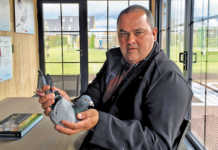It’s a sad fact that many show pigeon judges and eye-sign graders will try convince you to kill pigeons if they don’t make the grade by their standards. But, in pigeon language, we say the race basket will “select” the good from the bad. The judges can’t see the genetic make-up of their selection. As the saying goes, “the goodness is inside the oven before the cake is baked”.
The best show winners may not have the passing on powers to produce offspring which duplicate their quality. This is often the case even among the direct offspring of champion racers. Sometimes it’s just the “click” in a new-found match which produces champions on which an entire winning family is founded. Despite our best attempts to select “correctly”, pigeons often “pick” their own mates and become a “hit” pair.
It’s not only the judges who rate our pigeons. We all do, and we all dream about breeding a perfect pigeon with all the desired show and racing traits. The difference is, experienced fanciers will tell you it isn’t always the pigeons that qualify in the show pens that form the basis of a good racing loft.
The eyes in focus
The following provides some insight into what judges look for in the eyes. Although the eye ceres, around the eyes, may ideally be rather rough and thick to keep dust and wind from the eyes during flight, they may be a hindrance to sight if they’re too thick. Thin eye ceres can be protective without being a hindrance.
It’s advocated that an imaginary extended beak line should “cut” below the middle-half of the pupil. This means the eyes are placed closer to the brain because they are higher inside the skull. Although this idea has had merit in many pigeons of superior quality, there are too many exceptions.
Small pupils are always a desired trait in racing pigeons, but often reserved to pigeons of the long-distance type. But there are long-distance pigeon families that don’t generally have unusually small pupils. There are also short-distance pigeon families with exceptionally small pupils. The environment in which your pigeons are raised will also influence pupil size. Pigeons bred in darkened or well-lit lofts, over an extended period, will adapt in their phenotype.
Fanciers who kill breeding stock with large pupils make a grave mistake, as many such pigeons count among champion breeders. Textbook writers have complimented pigeons with well-granulated eye pigmentation as ideal in type and a better reflection of true quality. While it seems true that better-granulated eye pigmentation indicates better blood circulation, these pigeons definitely aren’t superior to those with denser eye pigmentation. Compared to between 30 and 50 years ago there seems to be a shift in the two extremes. Both exist in good and bad pigeons and one shouldn’t take them too seriously.
Fanciers who mate birds with “overfilled”, granulated eyes fail to observe the pupil is pushed unnaturally smaller to make way for the extra pigmentation. There are five circles in the eye. The second circle is the circle of adaptation, followed by the circle of correlation and then the circle of the iris. The fifth circle is seen when the circle of the iris gives way at its outer border to show the pigmentation below. These circles aren’t always intact or well defined. There are fanciers who won’t breed from pigeons that don’t show a fifth circle, but there are to many exceptions to the rule to take this belief too far. However, a match pair of note will often show a fifth circle in one of the pigeons within the mating.
I have seen countless pearl to pearl matings without a drop in quality. It’s wise, however, to not continue mating very light or dense-pigmented pearl-eyed birds together.Wide-circle correlation is the red circle before the iris pigmentation begins. Many fanciers want a large or wide circle of correlation, but there are too many exceptions to stick to this too closely.
The circle of adaptation is the second circle immediately “attached” to the outer edge of the pupil. Although I’ve seen countless champion breeders and racers with no significant circle of adaptation, it’s too prominent, especially among breeders of good long-distance pigeons. It is, however, not just the size but the darker and deeply cut circles, which are sometimes serrated at the outer edges, which are of good value.
The adage the eye is the window to the soul is true in the world of racing pigeons. An out-of-form, ill or distressed pigeon will first show it in its eyes. Dull, droopy, wet, colourless eyes are a sure sign something is wrong. A bright eye with extra sparkle is a sign of a fit, healthy pigeon.












